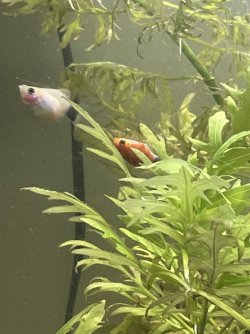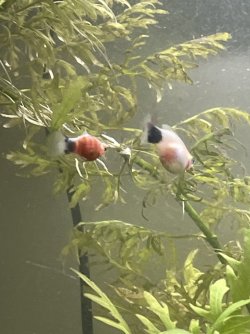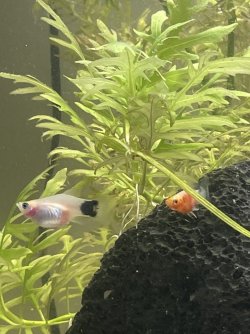It might be possible to get the other tank ready for her, if you'd prefer to have her in the other tank, and you have equipment for that tank? What kind of filter do you have on the main tank? Because you can often pinch a bit of filter media or squeeze out an established sponge filter from an established tank, to jump start a cycle on a new tank. Most of us with multiple tanks use that method to start a new tank, rather than go through the whole cycling process from scratch! Can also be handy to know how to do this if you need to whip up a quarantine or emergency tank urgently. Your current filter will have both types of bacteria needed to process ammonia and nitrites, so pinching some media or squeezing out the sponge filter when it's good and mucky means the new tank has the bacteria needed for a cycle. Then it's a case of growing the colony to handle the bioload in the new tank, and getting it nicely established. So it's not an instant cycle -doesn't make the tank fully established - so you need to test it often and water change as needed, but means you can get it cycled in a matter of days or a couple of weeks, rather than eight weeks plus when you start a cycle from scratch.
There's definitely a good chance fry will survive if she has them in the main tank! If the tank is kept well fed, fish are lazy and less inclined to hunt down fry, especially if the fry can dart under some thick cover. Some dense planting at the surface gives them the best chance, since the fry instinctively head to the surface. A big bunch of elodea, hornwort, water wysteria, guppy grass or similar gives some dense cover, and is easier for fry to navigate than a big adult fish.
Ignore how ugly this tank is, I inherited it, i didn't design it!
View attachment 130265
Even in this big tank with a LOT of fish in it, including those huge 4 inch mollies, a gourami and some zebra danios, bunches of fry survive, more than I can handle really.
Personally I favour letting nature take its course, since the ones that get eaten are likely to be the weakest and slowest, so it saves me having to cull them and make horrible decisions about what to do with weak/deformed fry, and I get more survivors than I really need. Means I have to move a lot more to grow out tanks and visit the local fish store more often to give him loads of young fish!
But, if you want to save as many as possible, a breeder net or moving to another tank is fine! You can monitor the tank for when the fry are born, then catch them and move them to the breeder net, or move the female when you see signs of labour. To move a gravid female, catch her in a fishnet, but don't lift her out Use a cup or jug, scoop that underneath the net, then lift her out by holding the net inside the cup/jug. Does that make sense? So she's being moved inside the jug of water, and not being lifted out of water. Reduces the chances of hurting her or the developing fry.
I've never used a loose breeder net for a female myself, does yours have a frame, like this?
View attachment 130266
If so, you could pop the female in there when you see some signs of labour. Otherwise, I'd check the tank first thing in the morning and last thing at night for fry, before turning the tank lights on, then net out the babies and put them in the breeder net.
I get plenty of fry that survive in this tank too, I don't use nets or boxes anymore unless something seems wrong. Livebearers produce so many fry, each month you get another batch! So all of us who keep livebearers fuss and worry a lot over the first few batches, wanting to save each fry possible, but you soon get a bit more chill about it, since you know there will be more batches coming each month!
Right now, the tank above has four different batches of fry growing up in there. One of the girls had her first batch, only six or so, then a batch of about ten, and the latest batch is A LOT. I can't possibly count them among all that plant, but based on previous batches and how many I see whenever I work on the tank, it's at least 40, and they swim openly in front of the adults, completely ignored by the adults!
Female livebearers store sperm, so even if you don't have any males around, she can continue popping out fry for months, using the stored sperm. Surprises a lot of people when they buy only female livebearers, and fry appear, but they didn't expect it since they didn't have any males! Often females have already been round males before they even arrive at the store, or a male has jumped tanks in the store.

 77E475ED-BB93-4EBD-8652-2A6414180AA2.jpeg246.4 KB · Views: 143
77E475ED-BB93-4EBD-8652-2A6414180AA2.jpeg246.4 KB · Views: 143 B54E4735-E711-4E21-AD81-39E8033F68ED.jpeg327.2 KB · Views: 103
B54E4735-E711-4E21-AD81-39E8033F68ED.jpeg327.2 KB · Views: 103 541FB370-1AF6-43A9-A462-8A343D719043.jpeg236.6 KB · Views: 102
541FB370-1AF6-43A9-A462-8A343D719043.jpeg236.6 KB · Views: 102 E1A90881-B759-4818-B653-03803602F59F.jpeg276.6 KB · Views: 95
E1A90881-B759-4818-B653-03803602F59F.jpeg276.6 KB · Views: 95 33268F49-81D3-4C39-A025-2542C3CB3097.jpeg244.8 KB · Views: 99
33268F49-81D3-4C39-A025-2542C3CB3097.jpeg244.8 KB · Views: 99

